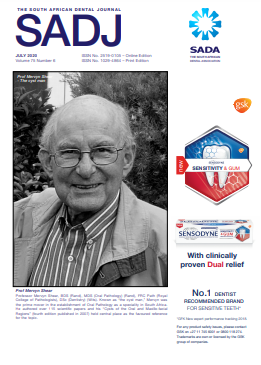Comparison of three different instruments for orthodontic study model analysis
DOI:
https://doi.org/10.17159/2519-0105/2020/v75no6a2Keywords:
orthodontic diagnosis, plaster dental models, Vernier callipers, needle pointed dividers, digital orthodontic study modelsAbstract
INTRODUCTION: A proper model analysis forms a vital part of the orthodontic diagnosis process, but it remains a time-consuming procedure. In day-to-day practice, many orthodontists assess the models subjectively, without applying analytical tests, due to the time it takes to do proper model analysis.1,2 Plaster dental models have long been the gold standard for orthodontic study model analysis and to calculate the Bolton index for tooth size disproportions, as well as intra-arch space discrepancies.3,4 Vernier callipers or needle pointed dividers are traditionally used to perform measurements on dental models.5 More recently digital orthodontic study models that are computer-based have been developed and have the potential to replace the traditional plaster orthodontic models.6 AIMS AND OBJECTIVES: The aim of this study was to do model analysis on one hundred orthodontic cases by making use of three different measuring tools. The objective was to see if a difference exists with regards to the measurements produced by the three different instruments and to compare the instruments with each other. MATERIAL AND METHODS: Three different instruments were used to measure Ave values on one hundred orthodontic study models. The three instruments included a Boley Gauge, Digital Vernier Calliper and Carestream 3600 scanner with accompanying software. The five values measured on the study models were: maxillary intercanine width, maxillary intermolar width, mesio-distal width of tooth 11, mesio-distal width of tooth 46 and mesio-distal width of tooth 41. RESULTS: The statistical analysis performed showed that the difference in measurements produced by the three instruments were not statistically significant for the inter-molar width (p = 0.849), intercanine width (p = 0.657), mesio-distal width of tooth 11 (p = 0.178) and mesio-distal width of tooth 41 (p = 0.240 The difference in measurements for the mesio-distal width of tooth 46 were statistically significant (p<0.01). However no clinically significant difference was found when the measurements produced by the three instruments were compared. CONCLUSIONS: All three of the instruments produced accurate measurements and can be used confidently when doing a comprehensive study model analysis for orthodontic diagnosis and treatment planning. The values produced were similar for all three instruments with insignificant differences between the three.
Downloads
References
Binder RE, Cohen SM. Clinical evaluation of tooth-size discrepancy. Journal of Clinical Orthodontics. 1998; 32: 544-6.
Sheridan JJ. The reader's corner. Journal of Clinical Orthodontics. 2000; 34: 593-7.
Stevens DR, Flores-Mir C, Nebbe B, Raboud DW, Heo G, Major PW. Validity, reliability, and reproducibility of plaster vs. digital study models: comparison of peer assessment rating and Bolton analysis and their constituent measurements. American Journal of Orthodontics and Dentofacial Orthopedics. 2006; 129: 794-803.
Quimby ML, Vig KW, Rashid RG, Firestone AR. The accuracy and reliability of measurements made on computer- based digital models. The Angle Orthodontist. 2004; 74: 298-303.
Shellhart WC, Lange DW, Kluemper GT, Hicks EP, Kaplan AL. Reliability of the Bolton tooth-size analysis when applied to crowded dentitions. The Angle Orthodontist. 1995; 65: 327-34.
Asquith J, Gillgrass T, Mossey P. Three-dimensional imaging of orthodontic models: a pilot study. European Journal of Orthodontics. 2007; 29: 517-22.
Proffit WR, Fields HW. Contemporary Orthodontics, 3rd ed. St. Louis: Mosby, 2000: 165-170.
Begole EA, Cleall JF, Gorny HC. A computer program for the analysis of dental models. Comput Prog Biomed. 1979; 10: 261-70.
Rudge SJ. A Computer program for the analysis of study models. European Journal of Orthodontics. 1982; 4: 269-73.
Yen CH. Computer-aided space analysis. Journal of Clinical Orthodontics. 1991; 25: 236-8.
Alcana T, Ceylanoglu C, Baysal B. The Relationship between Digital Model Accuracy and Time-Dependent Deformation of Alginate Impressions. The Angle Orthodontist. 2009; 79(1): 30-6.
Zilberman O, Huggare JAV, Parikakis KA. Evaluation of the validity of tooth size and arch width measurements using conventional and three-dimensional virtual orthodontic models. The Angle Orthodontist. 2003; 73: 301-6.
Garino F, Garino GB. Comparison of dental arch measurements between stone and digital casts. World Journal of Orthodontics. 2002; 3: 250-4.
Tomasetti JJ, Taloumis LJ, Denny JM, Fischer JR. A comparison of 3 computerized Bolton tooth-size analyses with a commonly used method. The Angle Orthodontist. 2001; 71: 351-7.
Hirogaki Y, Sohmura T, Satoh H, Takahashi J, Takada K. Complete 3-D reconstruction of dental cast shape using perceptual grouping. IEEE Transactions on Medical Imaging. 2001; 20: 1093-101.
Santoro M, Galkin S, Teredesai M, Nicolay OF, Cangialosi TJ. Comparison of measurements made on digital and plaster models. American Journal of Orthodontics and Dentofacial Orthopedics. 2003; 124: 101 -5.
Quimby ML, Vig KWL, Rashid RG, Firestone AR. The accuracy and reliability of measurements made on computer-based digital models. The Angle Orthodontist. 2004; 74: 298-303.
Downloads
Published
Issue
Section
License
Copyright (c) 2021 JC Julyan, Jennifer Julyan, Johny De Lange

This work is licensed under a Creative Commons Attribution-NonCommercial 4.0 International License.





.png)